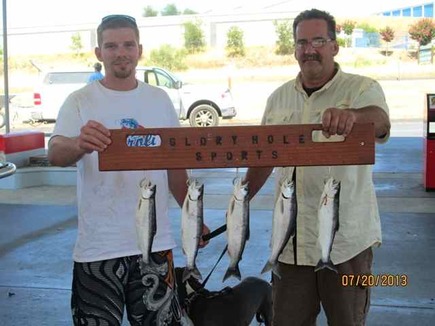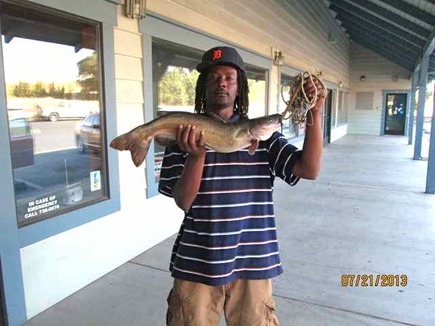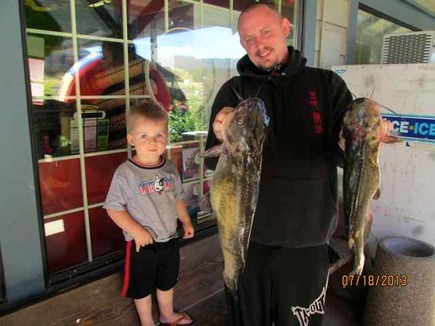Long Range Fish Report
From Sportfishing
From Sportfishing
Fish Report for 7-23-2013
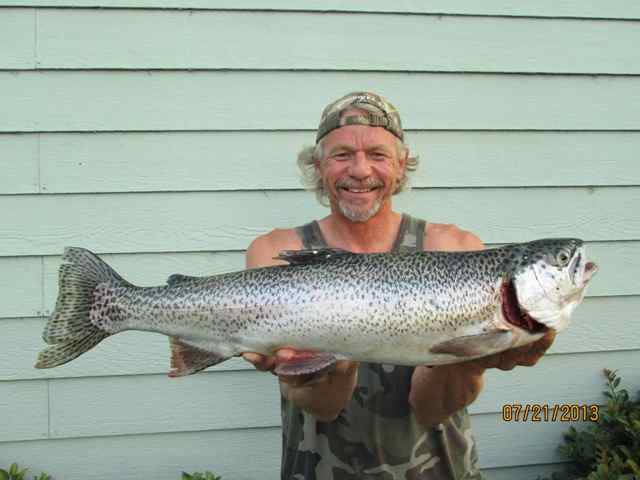
The Catfish bite is best at New Melones, followed by the Kokanee bite. Alll other species are slow
7-23-2013
Glory Hole Sports Staff
Water Conditions: New Melones Lake is currently holding 1,186,393 acre-feet of water. The lake level dropped two feet this week, and is currently at 967 ft. above sea level and 119 ft. from full. The average water temperature is a very warm 78-86 degrees. The lake is stained with mud lines forming near the shore in the afternoon.
Trout: Slow. The trout are hanging near the main river channel and major creek channels. They are avoiding the very warm surface temperature. Try to focus on deep cut banks and outside bends on these channels. Get a good contour map of the lake to locate these areas. The trout are primarily feeding on 3-5" shad in 40-60' of water. Night fishing anglers have been catching some chunky 2-pound rainbows near the dam and the spillway. Night crawlers and Power Bait have been the two most productive baits to use at night.
Pictured Above: Glory Hole Sports Big Fish of the Week Contest goes Richard Kowski. He caught a beautiful 3-pound, 7-ounce rainbow while fishing at night near the dam.
Trolling anglers have been catching a few fish while trolling for the kokanee. To target the trout try trolling at a faster speed with a Speedy Shiner or a crawler/spinner combo. Bank anglers try a marshmallow crawler combo or Berkley Garlic Power Bait. There are very few trout being caught from the shore. You might consider heading to one of the high country lakes for better bank fishing. Fly fishing anglers try fishing local rivers, creeks, and streams. Use beaded headed Prince Nymphs, Copper John's, and Pheasant Tails midday. In the evening try switching to a dry fly. Pale Morning Dunns, Adams, and Humpys are all good choices for dry flies.
Kokanee: Good. Anglers are catching their limits in 60-90' of water. The kokanee will suspend in cool water over creek channels in the main river channel. They will also use these channels in the late summer and fall to migrate for their annual spawn. The fish that are being caught are very fat, and up to 13-15" in length. There have been many fish caught on a variety of different baits. Glitterbug's Micro Hoochies, Uncle Larry's Spinners, Rocky Mountain Assasins, and Apex are few good choices that consistently produce fish. Pink is the number one color choice for either dodger or lure with green/chartreuse coming in a close second. Also, the water is a little stained and the fish are fairly deep. Try using gold and copper blades. They will stand out much better than silver in stained water and low light conditions. Don't forget to tip your bait with shoe peg corn and use plenty of scent on you lure and blade.
Photo #1: Steve and Shane Taroli of Placerville caught a nice limit of chunky kokanee. They reported catching them on orange hoochies near the 49 bridge.
Bass: Slow. Early morning and late evening try throwing top water, and reaction baits. Once the sun comes up the fish will pull off of the shoreline and out to deeper water. A Carolina rig is a great set up to cover water at many different depths. Try using baits with a large profile that will push more water. Lizards, brush hogs, and beavers are good choices for soft plastics. Another good way catch them is with a Texas rig worm. It is a good idea to use a bead under the weight to create a ticking noise. Also, with the fish being in deeper water, try dragging heavier ??-1oz. football head jigs. California Reservoir Lures makes a variety of jigs that work great in our Mother Lode lakes. If you do keep a bass, please keep the small spotted bass and release the big female (largemouth) black bass. Glory Hole Sports can teach you the difference, so you can practice good conservation of the species.
Photo #2: Mathew Pringle of Hayward caught a nice 6-pound, 4-ounce cat on anchovies.
Catfish: Very good. Anglers are catching plenty of nice cats with average size being 4-8 pounds. Most fish are in shallow water from 5-20". Melones catfish tend to be fish-eaters rather than bottom foragers, so use live minnows, frozen shad, mackerel, or anchovies for best success. Also, chicken liver and night crawlers work well to. To attract fish at night try soaking your bait in anchovy scent, bloody tuna scent or garlic scent. Target flat areas near deep water such as; island tops and long points. The catfish will use these areas as a dinner table to feed.
Photo #3: The Glory Hole Sports Big Fish of the Week Contest goes to Jeffrey Henry of Angels Camp. They caught two nice cats including a hefty one that weighed 8-pound, 10-ounces. They reported catching them near Tuttletown using shad for bait.
Crappie: Slow. Few fish being caught at night under a submersible light. Try using minnows or a red/white crappie jig. The crappie and bluegill are being forced to deeper water due to dropping water levels. This makes them very hard to locate and catch.
Trout: Slow. The trout are hanging near the main river channel and major creek channels. They are avoiding the very warm surface temperature. Try to focus on deep cut banks and outside bends on these channels. Get a good contour map of the lake to locate these areas. The trout are primarily feeding on 3-5" shad in 40-60' of water. Night fishing anglers have been catching some chunky 2-pound rainbows near the dam and the spillway. Night crawlers and Power Bait have been the two most productive baits to use at night.
Pictured Above: Glory Hole Sports Big Fish of the Week Contest goes Richard Kowski. He caught a beautiful 3-pound, 7-ounce rainbow while fishing at night near the dam.
Trolling anglers have been catching a few fish while trolling for the kokanee. To target the trout try trolling at a faster speed with a Speedy Shiner or a crawler/spinner combo. Bank anglers try a marshmallow crawler combo or Berkley Garlic Power Bait. There are very few trout being caught from the shore. You might consider heading to one of the high country lakes for better bank fishing. Fly fishing anglers try fishing local rivers, creeks, and streams. Use beaded headed Prince Nymphs, Copper John's, and Pheasant Tails midday. In the evening try switching to a dry fly. Pale Morning Dunns, Adams, and Humpys are all good choices for dry flies.
Kokanee: Good. Anglers are catching their limits in 60-90' of water. The kokanee will suspend in cool water over creek channels in the main river channel. They will also use these channels in the late summer and fall to migrate for their annual spawn. The fish that are being caught are very fat, and up to 13-15" in length. There have been many fish caught on a variety of different baits. Glitterbug's Micro Hoochies, Uncle Larry's Spinners, Rocky Mountain Assasins, and Apex are few good choices that consistently produce fish. Pink is the number one color choice for either dodger or lure with green/chartreuse coming in a close second. Also, the water is a little stained and the fish are fairly deep. Try using gold and copper blades. They will stand out much better than silver in stained water and low light conditions. Don't forget to tip your bait with shoe peg corn and use plenty of scent on you lure and blade.
Photo #1: Steve and Shane Taroli of Placerville caught a nice limit of chunky kokanee. They reported catching them on orange hoochies near the 49 bridge.
Bass: Slow. Early morning and late evening try throwing top water, and reaction baits. Once the sun comes up the fish will pull off of the shoreline and out to deeper water. A Carolina rig is a great set up to cover water at many different depths. Try using baits with a large profile that will push more water. Lizards, brush hogs, and beavers are good choices for soft plastics. Another good way catch them is with a Texas rig worm. It is a good idea to use a bead under the weight to create a ticking noise. Also, with the fish being in deeper water, try dragging heavier ??-1oz. football head jigs. California Reservoir Lures makes a variety of jigs that work great in our Mother Lode lakes. If you do keep a bass, please keep the small spotted bass and release the big female (largemouth) black bass. Glory Hole Sports can teach you the difference, so you can practice good conservation of the species.
Photo #2: Mathew Pringle of Hayward caught a nice 6-pound, 4-ounce cat on anchovies.
Catfish: Very good. Anglers are catching plenty of nice cats with average size being 4-8 pounds. Most fish are in shallow water from 5-20". Melones catfish tend to be fish-eaters rather than bottom foragers, so use live minnows, frozen shad, mackerel, or anchovies for best success. Also, chicken liver and night crawlers work well to. To attract fish at night try soaking your bait in anchovy scent, bloody tuna scent or garlic scent. Target flat areas near deep water such as; island tops and long points. The catfish will use these areas as a dinner table to feed.
Photo #3: The Glory Hole Sports Big Fish of the Week Contest goes to Jeffrey Henry of Angels Camp. They caught two nice cats including a hefty one that weighed 8-pound, 10-ounces. They reported catching them near Tuttletown using shad for bait.
Crappie: Slow. Few fish being caught at night under a submersible light. Try using minnows or a red/white crappie jig. The crappie and bluegill are being forced to deeper water due to dropping water levels. This makes them very hard to locate and catch.
Photos
< Previous Report Next Report >
More Reports
There is still plenty of water at New Melones!
New Melones ReservoirThere have been lots of comments from customers lately about how low the lake level is. "They are draining the lake!" "When are they going to have to close the lake because there are no usable boat ramps?" Stuff like that. So I want to take a minute to address lake levels. The current lake level is 967 feet above sea level. The last time it was this low was 2010- three years ago....... Read More
Glory Hole Sports Staff Reports
for Tuesday, July 16th, 2013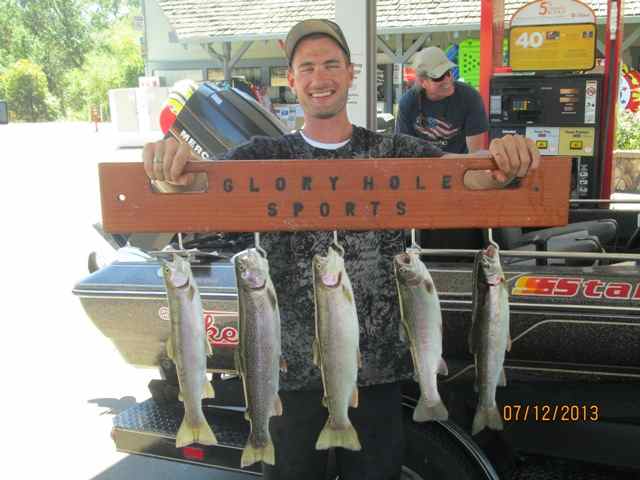
New Melones Reservoir: Results of Kokanee Power Tournament held last week at New Melones
New Melones Reservoir: Catfish & Kokanee are the best bet at New Melones, Bass & Trout are active but a little tougher

LongRangeSportfishing.net © 2025. All Rights Reserved.
Website Hosting and Design provided by TECK.net
Website Hosting and Design provided by TECK.net
